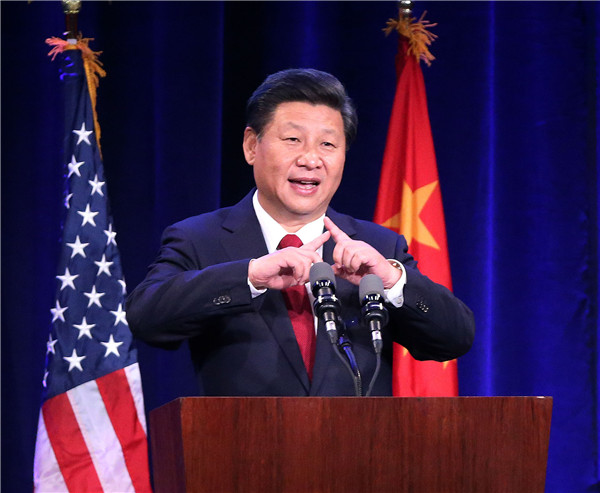What drives Xi's foreign policy?
Updated: 2016-01-08 07:58
By Robert Lawrence Kuhn(China Daily)
|
||||||||
 |
|
President Xi Jinping delivers a speech during a welcome banquet jointly hosted by Washington State government and friendly communities in Seattle, the US, Sept 22, 2015.[Photo/Xinhua] |
It's a question I'm often asked: What drives President Xi Jinping's robust foreign policy? The assumption is that Xi has upped China's global game, making the country's international relations more proactive and engaging, some say more muscular and aggressive. All recognize that China is now involved with every important issue in world affairs. Moreover, China is starting to shape the agenda of international discourse, not just react to the ideas and actions of others.
Examples of China's vigorous foreign policy under President Xi are well known: the Belt and Road Initiative reaching out to some 60 countries, Asian Infrastructure Investment Bank, new kind of major power relations with the US, strategic partnership with Russia, "golden era" in relations with the UK, high-profile state visits to Germany and France, support for African development, climate change, the list goes on. In less than three years as China's president, Xi has visited more than three dozen countries.
What motivates China's diplomatic transformation? There is no secret answer, no master plan hatched behind the guarded walls of Zhongnanhai, where China's leaders work in central Beijing. Rather, a confluence of factors comes together, enhancing China's role on the world's stage.
China recognizes that to be a major power, with its political influence approaching its economic strength, as well as to protect its own vital interests, the country must mount a pro-active diplomacy. Following are eight drivers, or underlying motivations, of China's new kind of foreign policy.
One, China has debilitating overcapacity in heavy industries, like steel, cement, aluminum, plate glass, chemicals, and if these can be transported and utilized by less developed countries, all benefit.
Two, China is embarking on its comprehensive 13th Five-Year Plan (2016-20), with the ambitious goal of becoming a moderately prosperous society by 2020. Foreign trade of higher value-added products, plus access to advanced foreign technologies, are an integral part of the Plan-and these can be facilitated by China's diplomacy and good image.
- Eight factors driving Xi's foreign policy
- Peaceful coexistence a cornerstone of foreign policy
- Xi's foreign policy is no secret
- Xi's worldwide diplomacy benefits China, the world
- Peace and development dominant themes of Xi's diplomacy
- Milestone year for China's diplomacy
- China's economic diplomacy innovative
- Use 'quiet diplomacy' to resolve sea issue
- Global health entering new era: WHO chief
- Brazil's planning minister steps aside after recordings revelation
- Vietnam, US adopt joint statement on advancing comprehensive partnership
- European border closures 'inhumane': UN refugee agency
- Japan's foreign minister calls A-bombings extremely regrettable
- Fukushima impact unprecedented for oceans: US expert

 Stars of Lijiang River: Elderly brothers with white beards
Stars of Lijiang River: Elderly brothers with white beards
 Wealthy Chinese children paying money to learn British manners
Wealthy Chinese children paying money to learn British manners
 Military-style wedding: Fighter jets, grooms in dashing uniforms
Military-style wedding: Fighter jets, grooms in dashing uniforms
 Striking photos around the world: May 16 - May 22
Striking photos around the world: May 16 - May 22
 Robots help elderly in nursing home in east China
Robots help elderly in nursing home in east China
 Hanging in the air: Chongqing holds rescue drill
Hanging in the air: Chongqing holds rescue drill
 2.1-ton tofu finishes in two hours in central China
2.1-ton tofu finishes in two hours in central China
 Six things you may not know about Grain Buds
Six things you may not know about Grain Buds
Most Viewed
Editor's Picks

|

|

|

|

|

|
Today's Top News
Liang avoids jail in shooting death
China's finance minister addresses ratings downgrade
Duke alumni visit Chinese Embassy
Marriott unlikely to top Anbang offer for Starwood: Observers
Chinese biopharma debuts on Nasdaq
What ends Jeb Bush's White House hopes
Investigation for Nicolas's campaign
Will US-ASEAN meeting be good for region?
US Weekly

|

|







